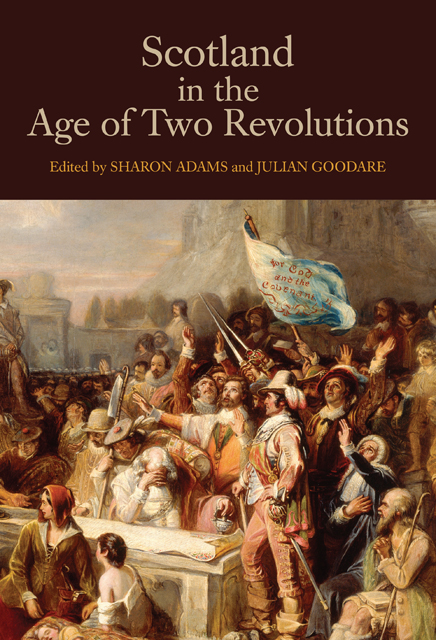Book contents
- Frontmatter
- Dedication
- Contents
- Figures and Tables
- List of Contributors
- Preface
- List of Abbreviations
- 1 Scotland and its Seventeenth-Century Revolutions
- 2 The Middle Shires Divided: Tensions at the Heart of Anglo-Scottish Union
- 3 The Western Highlands and Isles and Central Government, 1616–1645
- 4 The Scottish Bishops in Government, 1625–1638
- 5 The Scottish Revolution
- 6 In Search of the Scottish Republic
- 7 Highland Lawlessness and the Cromwellian Regime
- 8 The Worcester Veterans and the Restoration Regime in Scotland
- 9 The Political Thought of the Restoration Covenanters
- 10 Scottish State Oaths and the Revolution of 1688–1690
- 11 The Tribulations of Everyday Government in Williamite Scotland
- 12 The Company of Scotland and Scottish Politics, 1696–1701
- Chronology of Seventeenth-Century Scotland
- Further Reading
- Index
- Studies in Early Modern Cultural, Political and Social History
4 - The Scottish Bishops in Government, 1625–1638
Published online by Cambridge University Press: 28 February 2023
- Frontmatter
- Dedication
- Contents
- Figures and Tables
- List of Contributors
- Preface
- List of Abbreviations
- 1 Scotland and its Seventeenth-Century Revolutions
- 2 The Middle Shires Divided: Tensions at the Heart of Anglo-Scottish Union
- 3 The Western Highlands and Isles and Central Government, 1616–1645
- 4 The Scottish Bishops in Government, 1625–1638
- 5 The Scottish Revolution
- 6 In Search of the Scottish Republic
- 7 Highland Lawlessness and the Cromwellian Regime
- 8 The Worcester Veterans and the Restoration Regime in Scotland
- 9 The Political Thought of the Restoration Covenanters
- 10 Scottish State Oaths and the Revolution of 1688–1690
- 11 The Tribulations of Everyday Government in Williamite Scotland
- 12 The Company of Scotland and Scottish Politics, 1696–1701
- Chronology of Seventeenth-Century Scotland
- Further Reading
- Index
- Studies in Early Modern Cultural, Political and Social History
Summary
Thir unhappy bischopes they were eiuell counselloers, bot worsse musitians; for they tempered ther stringes to such a cleiffe of ambition and superstitious fooliry, that befor euer they zeildit aney sound, they burst all in peices.
In the Glasgow general assembly of November 1638, the Scottish episcopate was deposed in its entirety. With previous general assemblies declared null and void, the authority of the episcopate was abolished and the future of presbyteries was secured. All fourteen bishops were removed from their position as prelates, and nine of them were excommunicated. Charges levelled at the bishops included drunkenness, breaking the Sabbath, Arminianism, and responsibility for the hated Prayer Book of 1637. The words of Sir James Balfour quoted above, however, point to a further reason for the bishops’ downfall: their secular ambition and role as councillors to the king. These actions provoked the Scottish nobility into an alliance with the presbyterians, culminating in the National Covenant and the general assembly of 1638, and it is this secular role of the bishops that is under investigation here.
I
The Scottish Reformation had not wholly destroyed the episcopal system. From the mid-sixteenth century onwards an uneasy balance existed between the presbyterian and episcopal camps, with periodic struggles between the two. Despite continued efforts to secure the presbyterian system over the latter half of the sixteenth century, some form or relic of episcopacy was always evident in the Scottish church, such as the superintendents of the 1560s and the insultingly named ‘tulchan’ bishops of the 1570s. James VI made concerted efforts to re-establish episcopacy in Scotland, seeing the power and authority of the bishops over their dioceses and clergy as an important ally for royal interests. Following altercations between presbyterians and episcopalians, in 1600 James supported the appointment of three new bishops, significantly with the power to vote in parliament. Over the next few years, James gradually appointed a full complement of bishops and restored their jurisdictional powers, a process completed by 1612. Such moves, as well as the changes James sought to the liturgy, were fought by convinced presbyterians who argued against James’s authority over the kirk. Bishops, in particular, were seen by presbyterians as servants of the king rather than servants of God, and represented an unacceptable secular and civil encroachment into the religious realm.
- Type
- Chapter
- Information
- Scotland in the Age of Two Revolutions , pp. 59 - 78Publisher: Boydell & BrewerPrint publication year: 2014

